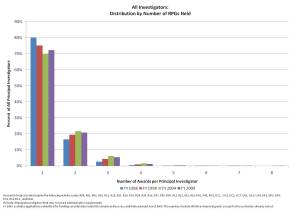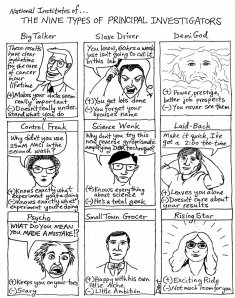GrantRant X
January 30, 2013
Open the grant you are polishing up right now, pronto, and change your reference style to Author-Date from that godawful numbered citation style. Then go on a slash and burn mission to make the length requirement. Because lets face it we all know your excuses about reading “flow” are bogus and you are just shoe horning in more text.
That numbered citation stuff is maddening to reviewers.
happy editing,
Uncle DM, Your Grant Fairy.
 This figure was posted by Sally Rockey, head of the Office of extramural research on her blog Rock Talking. We have discussed these data in the past but given my recent Fixing the NIH series of posts, I thought it worth bringing up.This depicts the number of investigators funded by the NIH who hold a given number of Research Project Grants as Principal Investigator. This includes a range of R-mechs, U-mechs, DPs, Program Projects, etc. As Dr. Rockey noted:
This figure was posted by Sally Rockey, head of the Office of extramural research on her blog Rock Talking. We have discussed these data in the past but given my recent Fixing the NIH series of posts, I thought it worth bringing up.This depicts the number of investigators funded by the NIH who hold a given number of Research Project Grants as Principal Investigator. This includes a range of R-mechs, U-mechs, DPs, Program Projects, etc. As Dr. Rockey noted:
If you crunch the numbers, you will see that in each of the four years presented more than 90 percent of our investigators hold one or two research project grants.
And, if as I do, you spy a slight trend for increasing numbers of grants per investigator over time, I refer you to my analysis of the real purchasing power of the full modular ($250K in direct cost per year) R01. The short version is that the full-modular of FY 2011 had 69% of the purchasing power of the same award in FY 2001. A PI needs about $350K per year to have the same grant. Also note that the chances of suffering budget reductions upon funding and even on non-competing renewal, due to ongoing Continuing Resolution problems with Congress, has increased relative to the early noughties. So a little aggregate creep in the number of grants per PI should be expected.
The reason for Dr. Rockey presenting these data in the first place coincides with my reason for posting the graph today. Because one of the very popular “fixes” for the NIH incorporates some version of the assertion that there are some PIs who enjoy a huge amount of funding and that by preventing them from doing so, we’ll be able to give a lot more people a basic level of support. “Blood from a stone” is not precisely the right aphorism here but suffice it to say, there aren’t enough of these hugely funded labs to make a difference. Yes, of course, one R01 subtracted from Professor MoneyBags could go to Asst. Professor J.R. Mint and thereby make a HUGE difference in her life. But on the order of systematic fixes…..this does little.
 This is the now famous cartoon by Dent which describes “types” of Principal Investigators. Obviously it is drawn from the perspective of trainees (no?) but it resonates with a timeless truthiness. To me anyway. And it is somewhat useful in our considerations for how to fix the NIH. We have to reduce the number of mouths at the trough, this is obvious. I’ve proposed that we need a prospective approach for the medium to long term future. I here renew my assertion that we need to get specific about which type of PI is to be put in the gunsights for reduction.
This is the now famous cartoon by Dent which describes “types” of Principal Investigators. Obviously it is drawn from the perspective of trainees (no?) but it resonates with a timeless truthiness. To me anyway. And it is somewhat useful in our considerations for how to fix the NIH. We have to reduce the number of mouths at the trough, this is obvious. I’ve proposed that we need a prospective approach for the medium to long term future. I here renew my assertion that we need to get specific about which type of PI is to be put in the gunsights for reduction.
Obviously, the answer is “That guy! over there….yeah, HIM. Not me, nuh-uh, I need to be preserved at all costs, dude!”
Sigh.
This is precisely why we need to have this conversation and precisely why the NIH needs to get more serious about making this hard call for themselves. Otherwise the culling will continue in an uncontrolled, random bolt-of-lightning fashion. Rockey called this “Darwinian” in (I think) a quote in a Science news bit AAAS bit. I don’t think that is quite the right term….laissez-faire maybe? At any rate. They are going to have to make the culling intentional if they have any interest whatsoever in 1) quality differences between funded investigators and 2) ensuring that the pool that remain after this great culling occurs is as high in quality* as possible.
One possible axis for pursuing this more-rational culling of the herd should involve thinking about types of operations. Small town grocer? Glamour Hound? Dreamer? Slave driver? Are any of these PI phenotypes associated with better value received for dollar spent by the NIH? Or is PI quality entirely uncorrelated with “type” of operation?
Raise your eyes back to the first graph. NIH has a lot of information on PI “type” based on the number of grants / dollars awarded. Some additional relevant information from University or Institute “type”. Does the size of the total NIH extramural portfolio (dollars, numbers of PIs, etc) at local institution influence success? They can, if they choose, do a bunch of retrospective peeking along a given PIs career track to see if a certain funding threshold at various points in the career are associated with success / failure. They need these data to evaluate Michael Eisen’s thresholds, btw.
I plead with you. As you engage in this discussion around and about…on blogs and in real life conversations….try to focus on the data we have. And the analyses that the NIH could conduct in the future. For these latter, demand them over at Rock Talk. Try to temper your knee-jerk “do it to that guy over there, my type of investigator is the BESTEVAH!!!” with some consideration of a larger picture. It is HARD. Believe me I know. Like I said elsewhere, I have no desire to be culled. None whatsoever. So obviously I’m looking very hard for arguments for why my type of scientist, my type of science, my type of job category and my type of institution are providing the best value. Given this, we should all double down on understanding and integrating data if it is available.
Recognizing that some 90 percent of PIs in the NIH system have only one or two RPGs is an example of what I mean.
Additional Reading on Fixing the NIH:
The NIH must dismantle the corrosive competitive culture of science
Shut off the PhD tap
We are going to fix the NIH
__
*yes there are many qualia that could be of interest here.